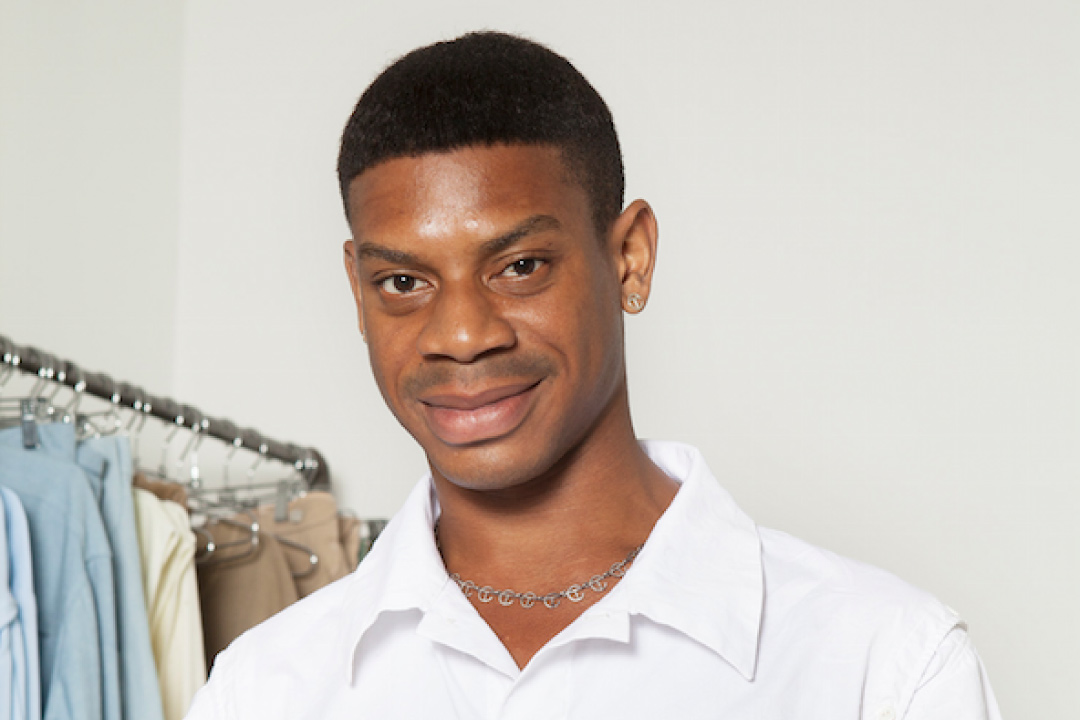
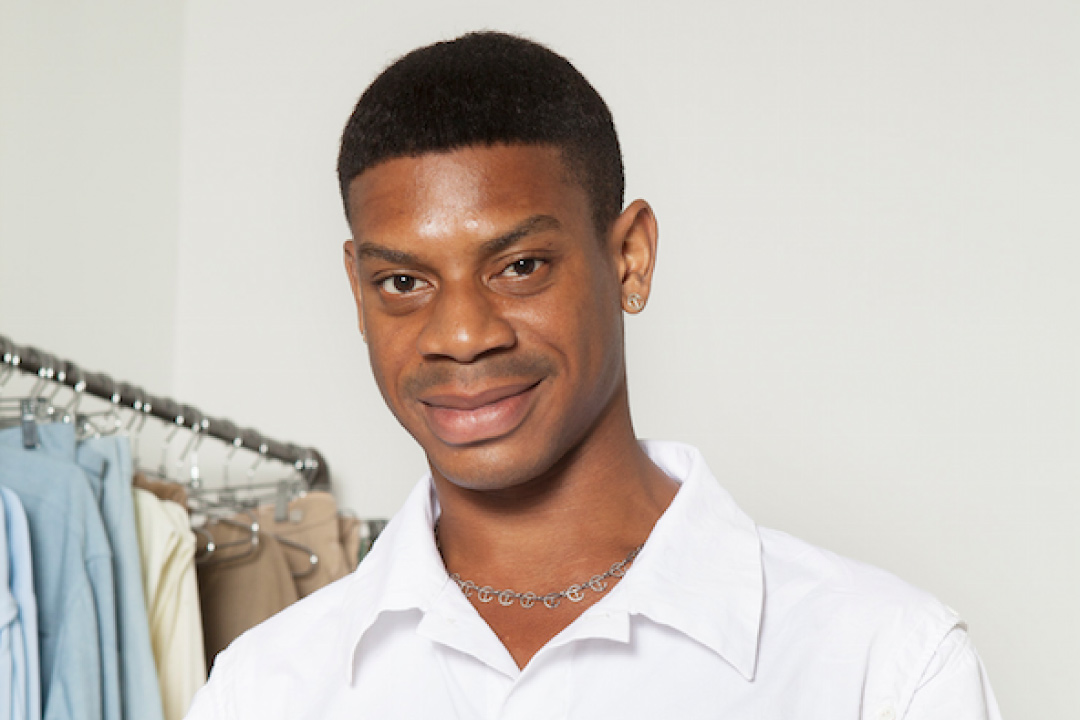
It’s a Saturday afternoon at the height of New York Fashion Week, and the world is about to get its first glimpse of the Telfar spring/summer 2015 collection. The venue is the Swiss Institute in SoHo – a clean, white, neutral backdrop for whatever is about to unfold.
We’re not uptown amid the frenzy of the Lincoln Center, the main venue for Mercedes-Benz Fashion Week, nor even at MADE Fashion Week, the Meatpacking District spectacle that tends to draw brands with a more cult following. But the tastemakers of the moment have made the trek. Here is Patrik Sandberg, senior editor at V magazine and VMAN. Over there is Jeanette Hayes, the post-internet painter named one of Paper magazine’s Beautiful People for 2014. And here’s Mike Hope, better known as @miketheruler, the 14-year-old fashion fan whose recent forays into the downtown scene have made him something of a Tavi Gevinson for the streetwear obsessed.
Guests take their seats. A hush falls as a man strides over to the white baby grand in the corner and begins a rendition of Lana Del Rey’s Summertime Sadness. The models appear – the first wearing a white Oxford shirt with detachable sleeves. Jeans sport holes torn at the knees, but as models continue to emerge, the rips migrate to latitudes rarely seen in the wild.
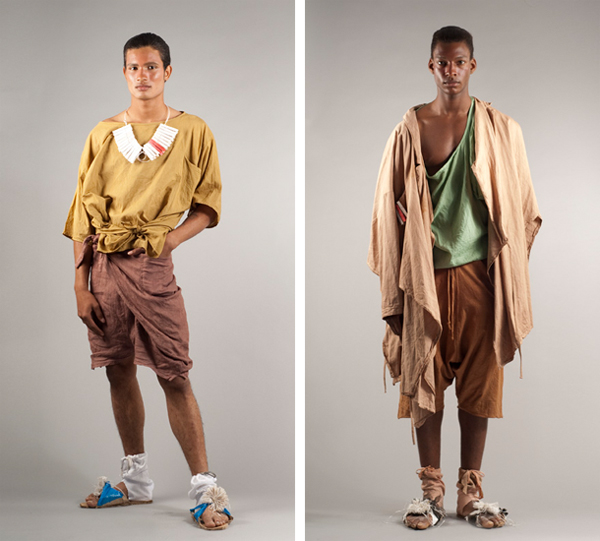
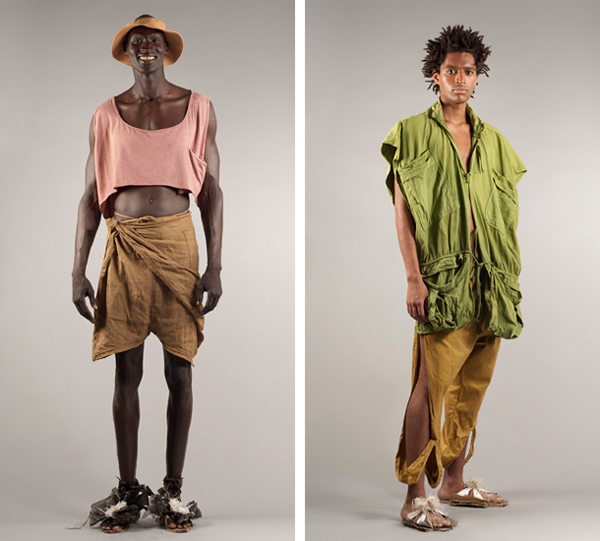
Soon we’re being treated to one-sleeve white polos, apron-like tank tops open at the back, and collared shirts with buttons that refuse to march down the chest in an orderly fashion, instead veering toward the models’ armpits. Men emerge in revealing and occasionally ass-less lingerie. The piano plays us out to the strains of Katy Perry’s Dark Horse.
“If you went to Nordstrom at the holidays, there’s a piano player,” Telfar Clemens, the collection’s namesake designer, explains a week later in between appointments to show the collection. We’re in a park near the showroom that the designer, 29, shares with the breakout brand Hood by Air. “We wanted to have that kind of elegant twist on really mainstream, top-40 hits,” he says. “It’s somewhat elevating it and creating something a little bit different from the normal perception of the song.”
The explanation makes sense: this is essentially what Telfar – already a mononym in these parts, like Cher – is doing with his clothes. Inspired by American mid-level brands like American Eagle and Old Navy, the designer takes these simple basics and adds details which, the more you look at them, seem a bit… off.
Much of the conceptual branding for Telfar comes courtesy of Babak Radboy, Telfar’s art director and a member of the New York group Shanzhai Biennial, which describes itself as a “multinational brand posing as an art-project posing as a multinational brand posing as a biennial”. Radboy has kept people guessing in his work for Telfar, too: in TCTV, the brand’s video lookbook for AW14, smiling models repeat the word ‘Telfar’ so many times that the whole thing begins to seem like a joke, or an extended trolling of the fashion world – but is it?
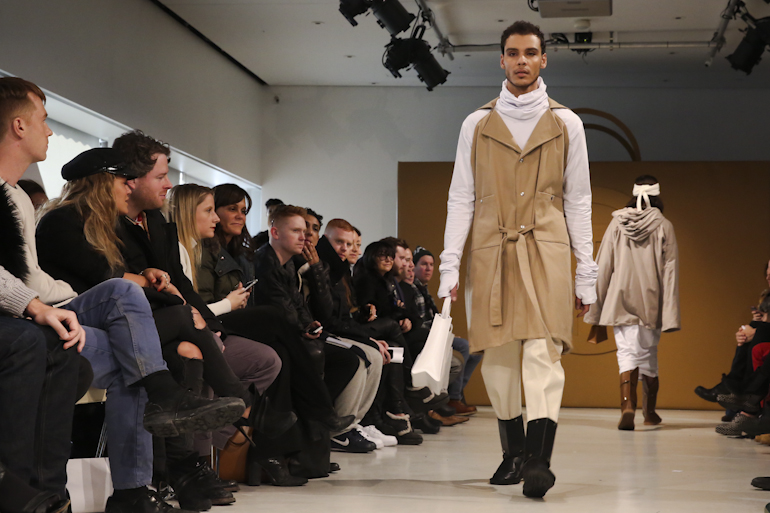
Actually, nothing's really normal anymore, the things that were abnormal before are now normal. The fact that we’re asking ourselves the question already makes this a more provocative brand than most. But Telfar is first and foremost a brand; he wouldn’t keep putting out collections season after season for nearly a decade if the whole thing were just some kind of performance art.
Telfar’s genuine enthusiasm for commerce shows when he begins to explain the design inspiration for his recent work. “When I was designing the AW14 collection, I was seeing all these people walking by holding numerous bags of goods that they were taking home for the holidays,” he says. “I thought that was the most beautiful, inspiring thing – that people were spending money and they have six different shopping bags. I was like, I want to make a bag that is that bag.”
The result is Telfar’s series of small, medium and large Shopping Bags, crafted in microleather with double straps, with the brand’s logo embossed on the side. They’re one of the few items you can actually purchase from Telfar’s online store. Another is the Get the Look series of T-shirts, which are printed with pictures of smiling models wearing the brand’s runway pieces. On the reverse, you find a block of dense black text – on a rock tour T-shirt, you get a list of cities; here you have the names of all the pieces from the SS14 season to remind yourself and others that you’re part of something bigger.
It’s all a bit meta, and a deliberate send-up of the way the fashion world operates. Legions of aspirational customers buy entry-level bags and logo-heavy T-shirts, which prop up the high-concept designs that define a brand, and that few can actually afford. But it’s also a business – Telfar isn’t completely kidding when he says he wants to be Michael Kors.
He’s aware, however, that there’s a limited market for one-sleeve polos. “Get the Look is for people who say, ‘I really appreciate the clothes, but I don’t want to wear them.’ It’s kind of a cynical twist on the whole T-shirt industry, and we just took it one step further by putting the look on the T-shirt.”
These gestures, which mix cynicism with humour, add up to a sense that Telfar gets it, which is probably why the cool kids are all suddenly flocking his way. But he’s been at this for a long time, designing clothes since he was a teenager and creating his namesake brand in 2006. Born in Queens, he spent his earliest years in Liberia, before relocating to New York City via suburban Maryland. This journey helps explain why the visual language of global fashion takes a turn through the outlet mall in his collections.
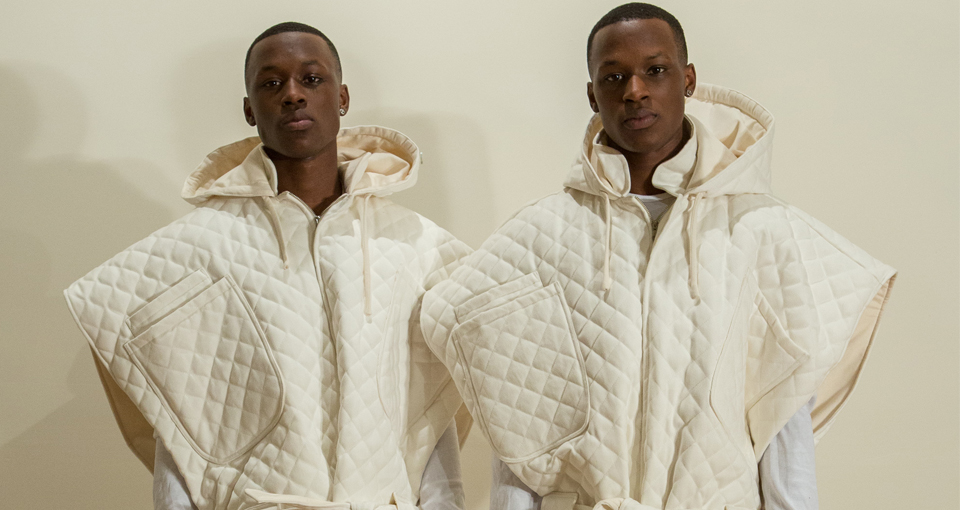
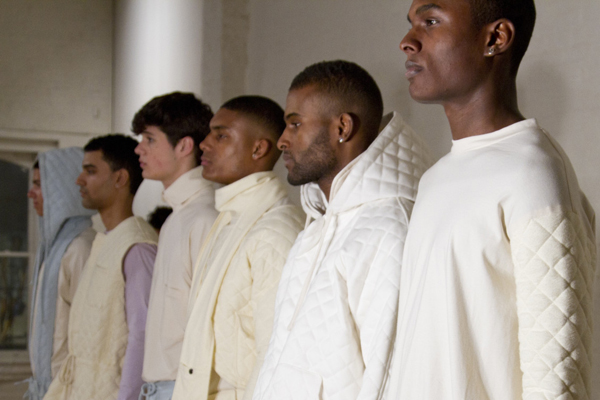
“I’m a very contradictory person – I’m never here nor there,” the designer confesses. “It’s a lot of mixes of things that come through in my work – for example, in the names of the styles, like a sarong short. It’s a fusion of design styles and concepts, but at the end of the day, they just reflect Telfar, that’s the only way to describe it.”
Recently, Telfar’s work has dovetailed with another strain in the zeitgeist, seemingly by accident. For last autumn’s reveal of the SS14 collection, Radboy coined the term Extremely Normal™ to describe the brand. Promotional text released at the time explained it as follows: “At once highly conceptual and obsessively practical, minimalist and irreverent, countercultural and mainstream, the Telfar line maneuvers with cunning the fashion landscape by defining a brand which is neither conceptual nor accessible. Simply put, it is extremely normal.”
Not long after, in October 2013, a group of New York trend forecasters called K-Hole released Youth Mode, a report that identified a new phenomenon that it termed Normcore. “Normcore moves away from a coolness that relies on difference to a post-authenticity coolness that opts in to sameness,” the report stated. “To be truly Normcore, you need to understand that there’s no such thing as normal.”
What might have remained an obscure trend report arrived at a moment when corporations had learned to deploy all the signifiers of DIY culture and artisanal connoisseurship for their own purposes. Sensing this, consumers have grown weary of the effort, and buying mainstream brands once scorned by the likes of Adbusters can feel oddly refreshing.
A few months later, when New York magazine brought K-Hole’s ideas to the masses in an article titled ‘Normcore: Fashion for One in 7 Billion’, the internet went nuts. Soon, Normcore referred to a specific style of bland dressing: 90s-influenced and heavy on the kind of mid-market brands that Telfar draws inspiration from.
Telfar has no particular affinity for the term, but his designs are more true to its original spirit than most of what came after. With Telfar, the surreal element is present and inescapable, in a way it isn’t, for example, in the new Gap campaign urging consumers to “dress normal”. “Actually, nothing’s really normal any more,” he says, echoing K-Hole. “The things that were abnormal before are now normal. It’s pink hair and a septum ring – even babies are wearing skull-print T-shirts. The way Extremely Normal started off just trickled into this new phase of what American fashion is going through right now, which is minimising certain things, and just really misinterpreting a lot of other things.”
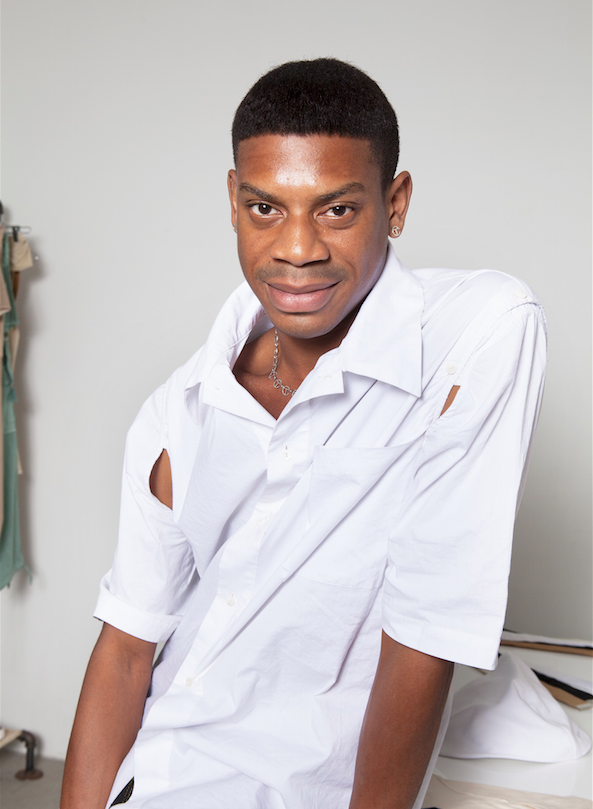
TCTV is again a case in point. It starts out blandly enough, with models smiling against a futuristic backdrop. But soon enough, the smiles start to last a little too long.
“The darkest thing is actually a smile,” Telfar says, with a big smile. “We like to mix that up: ‘it’s so beautiful that that person’s smiling!’ And then you move a little bit closer and it’s like … wait. You kind of see something a little bit sadistic in it.”
Unusually for a designer, Telfar is the face of his own brand, appearing in most of its visual materials, often online as a smiling, perpetually clapping gif image. For his AW14 presentation at the New Museum, he greeted visitors in the form of a seven-foot, 3D printed statue of himself.
“With the smiling and all of those things, it’s a brand image and it’s kind of like I don’t exist,” he says. “I’ve separated myself from the internet, but in the most public way. It’s very much a capitalist personality – I’m only smiling and holding pictures of my bags, being like, ‘buy!’ That’s what the internet is to me.”
At this point, Telfar is focused on expansion, wanting to reach as many consumers as possible – even the ones who currently shop at Old Navy. If it sounds unlikely that a brand that makes skimpy underwear for men would sell to Middle America, consider whether you’d expect mainstream teenagers to flock to a brand steeped in the most homoerotic imagery this side of dudesnude.com – and if not, try to explain Abercrombie & Fitch.
More immediately, the designer is planning to introduce a fragrance to his expanding product roster. “I feel like right now is my time,” he says with confidence. “Soon, there will be a Telfar version of everything.”
http://www.telfar.net/
Originally printed in Protein Journal #14



Discussion